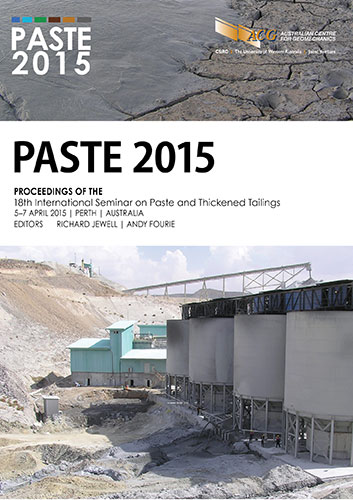Experimental study on the physical and mechanical properties of a cemented unclassified tailings backfill

|
Authors: Yang, XC; Liu, GS; Guo, LJ Paper is not available for download Contact Us |
DOI https://doi.org/10.36487/ACG_rep/1504_24_Liu
Cite As:
Yang, XC, Liu, GS & Guo, LJ 2015, 'Experimental study on the physical and mechanical properties of a cemented unclassified tailings backfill', in R Jewell & AB Fourie (eds), Paste 2015: Proceedings of the 18th International Seminar on Paste and Thickened Tailings, Australian Centre for Geomechanics, Perth, pp. 321-328, https://doi.org/10.36487/ACG_rep/1504_24_Liu
Abstract:
In order to study the physical and mechanical properties of cemented, unclassified tailings backfill, a series of unconfined compressive strength (UCS) tests have been performed on samples prepared in cubic and cylindrical shapes at 14, 28 and 56-day curing periods. Additionally, longitudinal wave velocities across all samples have been measured combined with ultrasonic pulse velocity (UPV), non-destructive testing technology. The influence of samples’ sizes, binder dosages and solids concentration the UCS and UPV were evaluated. The results indicate that samples with a diameter × height of 7.6 × 15.2 cm showed consistently higher UCS and UPV than those of 5 × 10 cm specimens at all solids contents and binder dosages, and the cylindrical specimens thus showed obvious size effects. Meanwhile, the samples with a side length of 7.07 cm (cube) showed higher UCS and lower UPV than the similar section size of 7.6 × 15.2 cm (cylinder) at the same binder dosage and solids content, and the end effects of cubical samples were more obvious. In addition, increasing the curing time led to the reduction of the ratio values for UCS and UPV of different size samples. Besides, with the increase of curing periods, a linear relation with a high correlation coefficient appears to exist between the UCS and UPV for the samples of specific sizes.
References:
Aubertin, M, Li, L, Belem, T & Simon, R 2008, ‘Évaluation despressions dans les chantiers remblayés et sur les barricades’ Proceedings of Symposium Rouyn-Noranda: Mines and the Environment, Canadian Institute of Mining, Metallurgy and Petroleum, Montréal, on CD-ROM, in French.
Aubertin, M, Bussière, B & Bernier, L 2002, Environnement et gestiondes rejets miniers, Presses Internationales Polytechnique, Montréal, on CD-ROM, in French.
Benzaazoua, M, Fall, M & Belem, T 2004, ‘A contribution to understanding the hardening process of cemented paste backfill’, Mineral Engineering, vol. 17, no. 2, pp. 141-152.
Belem, T, Bussière, B & Benzaazoua, M 2002, ‘The effect of microstructural evolution on the physical properties of paste backfill’, Proceedings of the 8th International Conference on Tailings and Mine Waste, A.A. Balkema, Rotterdam, pp. 365-374.
Fall, M, & Ghirian, A, 2014, ‘Coupled thermo-hydro-mechanical-chemical processes in cemented paste backfill and implications for backfill design –experimental results’, in Y Potvin & AG Grice (eds), Proceedings of the 11th International symposium on mining with backfill, Australian Centre for Geomechanics, Perth, pp. 183-196.
Fourie, A, 2009, ‘Preventing catastrophic failures and mitigating environmental impacts of tailings storage facilities’, Proceedings of the 6th International Conference on Mining Science & Technology, Elsevier B.V., Amsterdam, pp. 1067-1071.
Gongkang, F & Elwell, DJ 1995. Compression testing of concrete: cylinders vs cubes, special report 119, New York State Department of Transportation, New York.
Hassani, FP, Nokken, MR & Annor, A 2007, ‘Physical and mechanical behaviour of various combinations of minefill materials’, CIM Bullet, vol. 100, no. 1101, pp. 1-6.
Hassani, FP & Archibald, JF 1998, Mine backfill, Canadian Institute of Mining, Metallurgy and Petroleum, Montreal, Quebec,
on CD-ROM.
Kahraman, S 2001, ‘Evaluation of simple methods for assessing the uniaxial compressive strength of rock’, International Journal of Rock Mechanics and Mining Sciences, vol. 38, no. 7, pp. 981-994.
Li, L 2014a, ‘Generalized solution for mining backfill design’, International Journal of Geomechanics, vol. 14, no. 3, viewed 06 March2015, ascelibrary.org/doi/pdf/10.1061/%28ASCE%29GM.1943-5622.0000367
Li, L 2014b, ‘Analytical solution for determining the required strength of aside-exposed mine backfill containing a plug’, Canadian Geotechnical Journal, vol. 51, no. 5, pp. 508-519.
Li, L & Aubertin, M 2012, ‘A modified solution to assess the required strength of exposed backfill in mine stopes’, Canadian Geotechnical Journal, vol. 49, no. 8, pp.877-890.
Mitchell, RJ, Olsen, RS & Smith, JD 1982, ‘Model studies on cemented tailings used in mine backfill’, Canadian Geotechnical Journal, vol. 19, no.1, pp. 14-28.
Revell, B 2004, ‘Paste – how strong is it?’, Proceedings of the 8th International Symposium with Backfill, Nonferrous Metals Society of China, Beijing, pp. 286-294.
You, MQ, Su, CD & Li, XS 2008, ‘Study on relation between mechanical properties and longitudinal wave velocities for damaged rock samples’, Chinese Journal of Rock Mechanics and Engineering, vol. 27, no. 3, pp. 258-267.
Zhu, JS & Song, YP 2004, ‘Research on fatigue damage of concrete under biaxial compressive loading using ultrasonic velocity method’, Chinese Journal of Rock Mechanics and Engineering, vol. 23, no. 13, p. 2230.
© Copyright 2025, Australian Centre for Geomechanics (ACG), The University of Western Australia. All rights reserved.
View copyright/legal information
Please direct any queries or error reports to repository-acg@uwa.edu.au
View copyright/legal information
Please direct any queries or error reports to repository-acg@uwa.edu.au